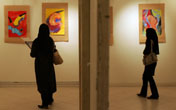
Censorship and the apple in Iranian Cinema
Censorship and the apple in Iranian Cinema
Tehran-Interest in art is an important part of the Iranian national character, from the days before the Islamic Revolution, until now. Similarly, evading and outmaneuvering the censors is parcel of the process of cultural and artistic production in the country. Just as in the times of the Shah, censorship and prohibition permeate Iranian society of today. This state of affairs is, perhaps, responsible for filmmakers employing unconventional ways of expressing themselves. When Iranian female director, Samira Makhmalbaf wanted to portray freedom, in one of her films, she used a dangling apple no one dared to pick.
This unconventional cinematic style goes a long way to explain the rising international star of Iranian art and cinema in particular. For example, in 2004 alone, films produced in the Islamic Republic received over a hundred international awards and mentions in film festivals worldwide for direction and acting, due to the excellent efforts of distinguished filmmakers and artists, such as Abbas Kiarostami and Bahman Qobadi. However, in terms of output, the Iranian film industry is not large, with the number of films produced every year not exceeding fifty. The Ministry of Culture and Guidance, which supervises film production, is working to increase the number to three hundred.
Among the more important new releases are “Coma”, “Mehman- e maman” (Mom’s guest), “Khwabkah Dakhtran” (The sleep of girls), “Doel” (Lonely confrontation), and “Marmoulak” (The Lizard) by Kemal Tabrizi. The last film was banned in Iran because of the implicit criticism of Mullahs (Muslim clergy) in its story of a thief who escapes from prison disguised as a Mullah. The fugitive then starts preaching to the public and is surprised by the reception he receives. Despite the harsh reaction of the religious establishment in Iran , the Presidential candidate Hashemi Rafsanjani has asked Tabrizi to direct his campaign advertisement.
Despite this relative boom, those who work in the Iranian film industry complain of a shortage of move theatres. There were 427 theaters across Iran in 1978, with a population of 36 million. In 2004, however, the number has decreased to 306 while the population has almost doubled. This indicates a lack of investment in cinema over the last twenty five years. Experts say that the post-revolution political system hasn’t paid as much attention to moviemaking as other issues. If cinema is flourishing in Iran , it is the result of individual efforts, they add.
Just as in other countries, cinema in Iran suffers from censorship. In Marmoulak, for example, Tabrizi was forced to delete a number of major scenes. As a response to this government control, artists in cinema and theatre have resorted to making social and comical films. Censorship, however, hasn’t only had a negative impact on art in Iran . Red tape and restrictions imposed by the authorities have created what can be referred to as a “responsible cinema” that is devoid of violence, sex, and immorality. This has given Iranian cinema a much celebrated identity and meant that films are much more close to philosophical ideas and symbolic representations.
Overtly political cinema has no place in Iran these days, even though the country is rife with internal conflict and dissent. Filmmakers have traditionally veered clear of this subjected, except in movies about the war with Iraq , which lasted from 1980 until 1988, which are no longer popular. One director, Behruz Afkhami regards this type of cinema as the worst of its kind, because he believes it is corrupted for political and ideological purposes and no longer conveys the real cinematic message. However, another film critique, Khalil Nabawi, is sad at the absence of political cinema, given that only serious cinema can bring about healthy criticism and political dialogue.
Iranian laws do not allow the import of foreign films from any country. There are, of course, exceptions to this rule. The authorities permitted the distribution of “Fahrenheit 9/11” and “The Passion of Christ” last year, both critically acclaimed, internationally. They received a lukewarm reception in Iran , perhaps because of the low number of movie goers across the country, with many preferring to follow satellite television stations and watch DVDs.
Theatre
Theatre in Iran is in no better state than cinema, as it has remained stagnant in the last two decades, despite man realizing its importance. At present, Tehran has about 23 theatre halls, with many closing down due to lack of investment and public disinterest and no new ones being built. Plays currently showing across the country are Iranian and foreign, with the former attracting a larger audience.
Music
Music is a complicated subject in Iran , due to the presence of several laws and religious edicts that differ widely on their treatment of the subject, in a country where religion is the basis of society. Consequently, there is wide debate between musicians and the religious establishment. In general terms, musical production is not encouraged by the Iranian authorities, who try to undermine the genre by not offering any support to makers of musical instruments. This hasn’t prevented the emergence of a number of bands such as Areen, Kab, Bart, Bad Boys, Sun Boys, and “6+1”, with a Pop or Jazz musical sound.
Kambeez Rezaei, a young Iranian singer and musician, describes the modern Iranian sound as a mixture of Arabic and Persian music, and Western Jazz. He complains of restrictions by various government organs, like the national television and radio stations, when they acquire Iranian musical product. For their part, Iranian satellite television stations that broadcast from aboard, such as “Muhajer” (the migrant) from German, promote Iranian music when they buy the latest releases and show them worldwide. This goes to show that, despite all the difficulties it faces, art in the Islamic Republic is finding its way to international markets.
